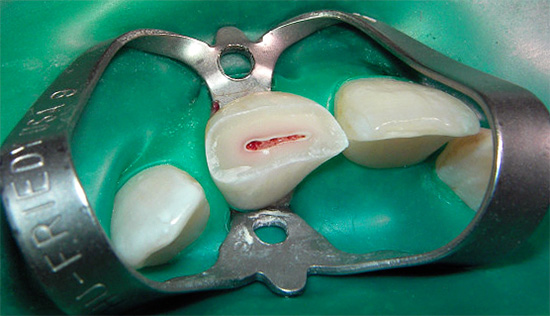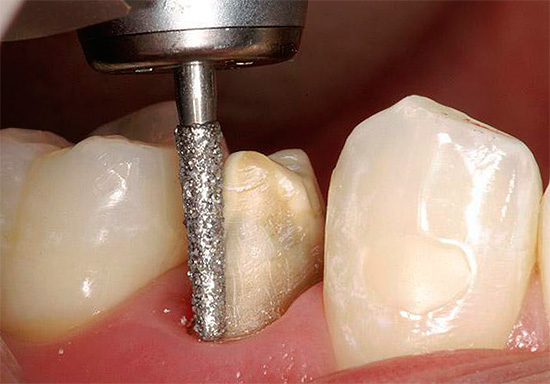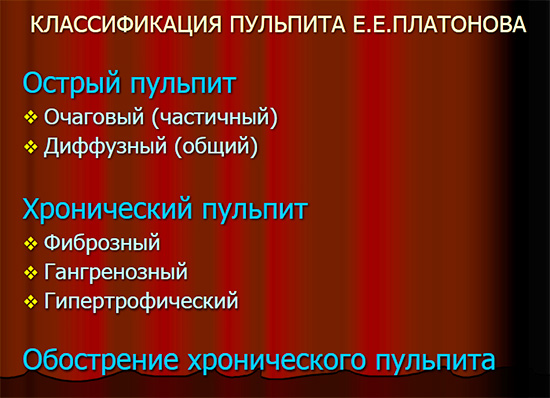
Currently, more than 20 classifications of pulpitis are known, some of which are still used by practicing dentists in the process. However, not a single classification of pulpitis is universal, since it is not able to reflect with 100% accuracy the features of a particular type of pulpitis from all, so to speak, “angles” of this disease.
It is interesting
Such a large number of pulpitis classifications is explained by different approaches to the description of each type of one, in general, disease. The authors tried to reflect in their grouping the causative factors of the occurrence of the disease, clinic, development, underlying processes that occur in the channels of the tooth with pulpitis, etc.
However, no one has been able to describe everything at once in a single systematization. Few people managed to combine in one classification several of the most significant aspects of the disease for each of its varieties, as close as possible to the ideal systematization for a practicing dentist. It is these working classifications that dentists still use, despite the fact that many years have passed since the appearance of many of them.
To classify pulpitis tried at the beginning of the last century. One of the earliest classifications was proposed in 1925, but was too cumbersome and did not reflect the exact description of each subspecies of the disease. However, the work to create a systematization of pulpitis, convenient for practicing dentists, did not stop: approximately every 5-10 years a new group was published, often having certain similarities with previous classifications, or differing from them in literally one or two altered sections.
At the end of the 20th century, the international classification of diseases of the 10th revision was published, or in abbreviated form - ICD-10 under the leadership of WHO (World Health Organization, English. World Health Organization or WHO). The classification of pulpitis according to ICD-10 officially began to be applied in practice in 1999 for statistical accounting of the work of a dentist. A special code is put in the coupons of the dental patient (according to ICD-10), which allows encrypting one or another type of pulpitis.

Unfortunately, this classification is still used as a statistical report of the doctor on the work performed for the day, month and year. It does not reflect the real picture., as for the same pulpitis, the classification for each type considers some aspects of the disease and is difficult to write, which is why a dentist who has been using systematization convenient for him for many years puts a code in the dental patient’s coupon that encrypts just like the type of pulpitis treated by him the day before .
Varieties of pulpitis by origin
In total, 4 types of pulpitis are distinguished, which differ in origin. Let us briefly review the features of each of them.
Infectious pulpitis
Inflammation of the neurovascular bundle inside the tooth most often occurs as a result of the aggressive effects of microorganisms and their toxins on living pulp tissue. It is the bacteria that determine the infectious etiology of almost every pulpitis.
The classic way of "infecting" the pulp with its subsequent inflammation is the penetration of microbes from the carious cavity deeper into the dentinal tubules or (less commonly) their direct effect on the already opened "nerve". These two options are found in more than 90% of cases.

On a note
Sometimes there is the so-called retrograde route of infection to the pulp.Retrograde pulpitis occurs if microorganisms (for example, it can be staphylococci, streptococci, putrefactive bacteria, etc.) penetrate into the tooth not through the carious cavity, but through the apical hole in the root. This sometimes happens with acute respiratory infections, osteomyelitis, rubella, and some other diseases.
A hematogenous (through the blood) source of pulp infection is not common, since the body's defenses usually manage to block pathogens long before they enter the arterioles that feed the neurovascular bundle of the tooth. Retrograde infection also includes the penetration of microbes from foci closest to the root of the tooth, for example, with sinusitis, periodontitis - also through an opening in the apex of the root.

Traumatic pulpitis
This name reflects the origin of pulpitis, but not the processes that develop in the damaged pulp. Injury, which is most often just the trigger of the “nerve” disease, in a short time starts the infectious component of the further development of pulpitis and its progression.

Normally, the pulp is always in sterile conditions. When it is opened during a tooth injury, bacteria from the oral cavity, which previously were conditionally pathogenic, rush into the pulp chamber of the tooth, where they cause the development of an infectious inflammatory process.

On a note
Most often, pediatric dentists are faced with traumatic pulpitis, since it is children who are often susceptible to various injuries with damage to the maxillofacial region. The disease can develop as if milk bite, and when constant. Most often, the upper central and (or) lateral incisors are damaged, but in certain situations the lower front teeth can also be damaged.
Traumatic pulpitis can occur not only with a fracture of the crown, but also with severe bruising of the tooth, its dislocation and subluxation or root fracture, when pulp necrosis (necrosis) occurs inside the tooth. In these cases, the disease develops without the participation of pathogenic microflora - it can be said, in the closed state.
As practice shows, the main types of injuries leading to the development of traumatic pulpitis are the following:
- Household;
- Transport;
- Gunshot;
- Iatrogenic (arising due to the fault of the doctor).
Pulp injury due to the fault of the dentist deserves special attention. Unfortunately, there are no accurate statistics of the iatrogenic factor in the development of pulpitis, since possible problem situations, even if they arise, are immediately resolved on the spot through communication between the dentist and the patient - the doctor simply cures the tooth, which he himself brought to pulpitis.
For example, in case of accidental overheating of the tooth during the preparation of caries, odontopreparation (“grinding”) of the tooth under the crown, during perforation of the pulp chamber during treatment deep caries - in all these cases, after some time, traumatic pulpitis almost always develops, requiring immediate treatment.

From the secrets of the dental "kitchen"
Patients, due to the fact that they have little knowledge of the intricacies of dental treatment, usually trust the specialist in everything. And there are many dentists who use this with pleasure, turning ordinary deep caries into pulpitis.
Why is this happening? In private clinics, the treatment of caries is several times cheaper than the treatment of pulpitis, so the temptation is to tell the patient that he supposedly has a "carious cavity so deep that almost the nerve is visible." And accordingly, instead of filling, the tooth is “given” in full.
In budgetary institutions, where admission is free or almost free, everything happens differently, but no better: a patient comes with deep caries, but the doctor sometimes does not have time (another 15 people are waiting in the corridor), desire, and most often the diagnostic apparatus ( e.g. EDI) to determine the diagnosis of a given tooth. Therefore, to prevent a second meeting with the patient, the dentist "just in case" opens the pulp chamber and removes the "nerve" from the channel (s).
If it was possible to keep statistics on pulpitis, “arising out of nowhere” right at the dentist’s appointment, then they would probably have taken first place in a number of dental clinics.
Calculus pulpitis
Concrement pulpitis has a non-infectious origin: it is a consequence of metabolic disorders in the neurovascular bundle of the tooth during its long compression by the so-called denticles or petrificates - formations that, appearing in the channels, can compress blood vessels, disrupting the blood microcirculation in the pulp with the formation of its edema turning then into pulpitis.


The intensity of irritation of the nerve endings of the pulp determines the severity of pain in calculus pulpitis.
Medication (“chemical”) pulpitis
In modern classifications, it is not distinguished, but in practice this type of pulpitis is often found, like the same iatrogenic factor or a doctor’s mistake. Chemical burn of the pulp occurs, for example, in the following cases:
- when used by a dentist during drug treatment of a prepared carious cavity of potent substances (alcohol, ether);
- with the wrong technique for using seal materials (for example, without gaskets);
- when introduced into the periodontal pocket during the treatment of periodontitis, potent drugs that can penetrate into the pulp through root cement or through the apical hole.

Pulpitis classification according to Platonov: a brief description of each type
Until now, practicing dentists in Russia use the classification proposed by Professor and Doctor of Medical Sciences Platonov Yefim Yefimovich back in 1968. Despite the fact that it is not without certain drawbacks, its author, unlike many of his predecessors, was able to significantly simplify the classification of pulpitis and make it clearer for a wide range of practicing dentists. In one classification, he tried to characterize not only the pathological processes that occur with pulp in one form or another of pulpitis, but also noted the course of the disease and the localization of pain.

Platonov E.E. in his classification, he identified three main types of pulpitis in the course of the disease: acute, chronic and exacerbation of chronic pulpitis. At the same time, in acute pulpitis, he noted two forms: focal and diffuse, where he emphasized the localization of pain.
Focal form - a person accurately indicates the "center" of pain. Diffuse pulpitis - means the diffuse nature of the pain when it radiates (“shoots”) along the trigeminal nerve into the eye, ear, neck, etc. Here, the author neglected the processes taking place inside the tooth, thereby simplifying the diagnosis for practicing doctors, especially at a routine appointment.
Indeed, dentists still treat more than 10-15 people per shift at a budget reception, and there is no point in going into details about the process that takes place in the tooth channels: serous or purulent, as noted by the authors of previous classifications. It’s enough to understand the exact diagnosis on 1-2 leading questions (adjusted for the need to clarify whether the person has had the same acute pain in the past, since the exacerbation of chronic pulpitis similar in symptoms acute form).
Platonov borrowed the chronic forms of pulpitis for his classification from previous authors, highlighting:
- Fibrous;
- Gangrenous;
- Hypertrophic.

These forms of pulpitis in the classification of Platonov do not reflect the etiology (the cause of the development of inflammation of the "nerve"), but the processes occurring in the pulp. The fibrous form characterizes fibrous degeneration of pulp tissue, gangrenous - gangrene (necrosis) of the pulp, and hypertrophic - hypertrophy (proliferation) of the neurovascular bundle with filling of the carious cavity.
On a note
In the Comedy Club program in one of the episodes, the famous host Garik Martirosyan, commenting on the picture where, to put it mildly, not quite a Hollywood smile, defined the unfortunate “pulpitis of the third degree”. In fact, such a diagnosis does not exist in the system of classifications known to the world.
ICD-10 Pulpitis Classification: Adapted Version
The World Health Organization (WHO) at the end of the 20th century, thanks to leading world experts in various fields of medicine, created a classification of known diseases, which included the section “Diseases of the oral cavity, salivary glands and jaws”. This classification was called ICD-10, and provided practicing dentists with a detailed division of pulpitis and periodontitis into types and forms.
And one of the most difficult for a practicing dentist was the classification of pulpitis according to ICD-10.

On a note
Dentists, accustomed to convenient and simple classifications, which have been reflected on medical records for many years, were forced to enter the required disease code with their code in the statistical coupon of the dental patient according to variety. If with encryption of the most basic disease (caries, pulpitis, periodontitis, etc.) there were no hiccups, but serious problems started with the encoding of the exact form or type. Therefore, even then an unofficial translation of the classification according to ICD-10 into the “language” of practicing doctors was made:
K04.00 - initial pulpitis or hyperemia of the pulp is translated as "deep caries", K04.01 - acute pulpitis - means "acute focal", K04.02 - purulent pulpitis, pulpal abscess - characterizes acute diffuse pulpitis, etc. Many doctors (where there is no close monitoring of the details of ciphers) have done even easier: for any pulpitis they always put the general code K04.0, which simply means “Pulpit”. It includes 9 forms in absentia: from acute (chronic) and ending with specified and unspecified.
To paraphrase Mayakovsky’s words: “if every form of pulpitis is encoded, does anyone need this?” However, many medical practitioners still have no answer to the question of who needs this at all ...
Classification of pulpitis in children by T.F. Grape
Because pulpitis in children they can be in permanent and primary teeth, they take into account the degree of formation of the internal structures of the tooth, age-related changes, have the most unpredictable clinical picture (due to communication difficulties, the unripe psyche of the child, etc.) - because of all this, a separate classification of pulpitis, taking into account the clinic and simplifying the diagnosis of each of the forms at one or another stage of development.

T.F. Vinogradova proposed an extended classification of pulpitis of permanent and temporary teeth in children. She determined that acute pulpitis in milk and permanent teeth proceeds differently, so she distinguished two sections. In the first she included:
- acute serous;
- acute purulent;
- and acute pulpitis with involvement of periodontal tissues and regional lymph nodes in the process.
For the second section of pulpitis of permanent teeth in children, she introduced:
- acute serous partial pulpitis for teeth with formed roots;
- acute serous and purulent general pulpitis;
- as well as acute purulent partial pulpitis.
For chronic pulpitis of permanent and temporary teeth in children, Vinogradova noted forms that are partly similar to Platonov's classification of pulpitis:
- simple chronic;
- chronic proliferative;
- chronic proliferative hypertrophic;
- and gangrenous pulpitis.
The last section is an exacerbation of chronic pulpitis of milk and permanent teeth.
This is not to say that this classification is universal for pediatric dentists, however, practicing doctors have actively addressed and are turning to it, despite the fact that it was created already in 1987.
On a note
For most practicing dentists at a dental appointment, it is not so much a classification of each type of pulpitis that is required, but a fundamental difference between the inflammation of the neurovascular bundle and periodontitis, a disease that involves the tissues surrounding the root of the tooth in the inflammatory process. With rare exceptions when making a diagnosis of “pulpitis” (no matter what), the dentist begins endodontic treatment of the tooth canals, and you have to think about its exact form when describing medical documents, although sometimes it is perceived as an unnecessary formality, and invented by the doctor on the go .
This is especially true for coding the diagnosis in dental patient coupons according to ICD-10. In other words, whatever the pulpitis of origin, course, severity, shape, etc., the dentist almost always does the same. And why then do you need to break the disease into subspecies? Apparently, to make it easier to distinguish a variety of pulpitis from a similar form of periodontitis.
Useful video about pulpitis and its features
And this is how pulpitis is treated: all stages can be followed






